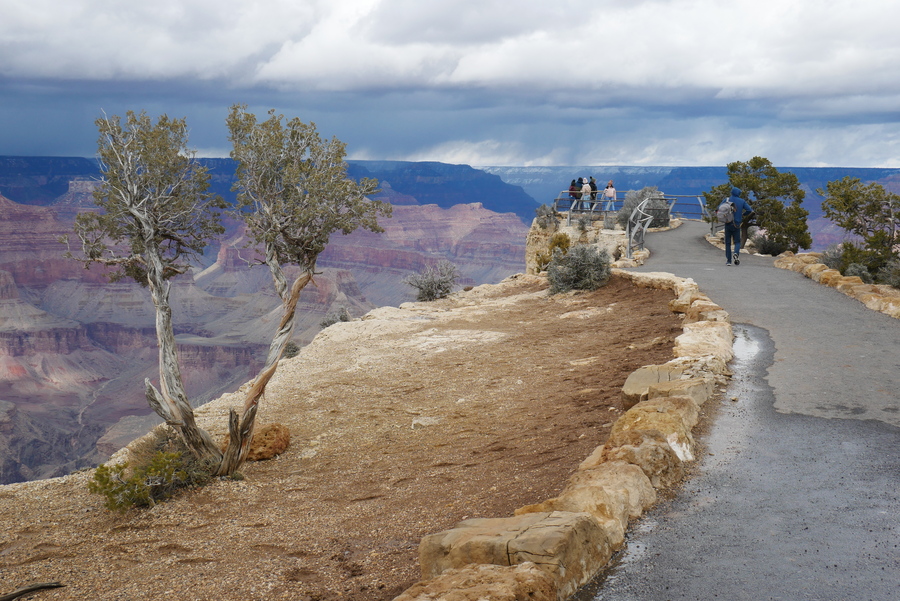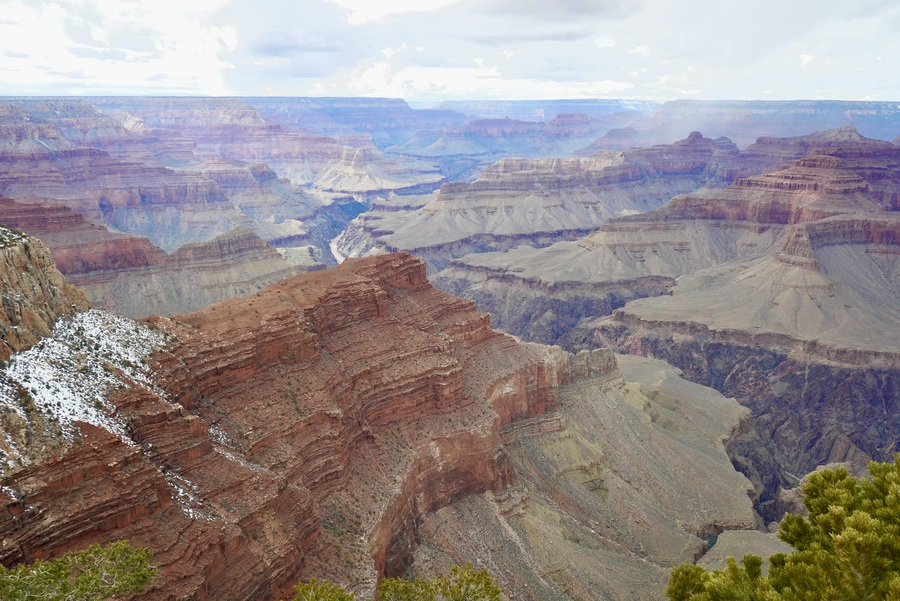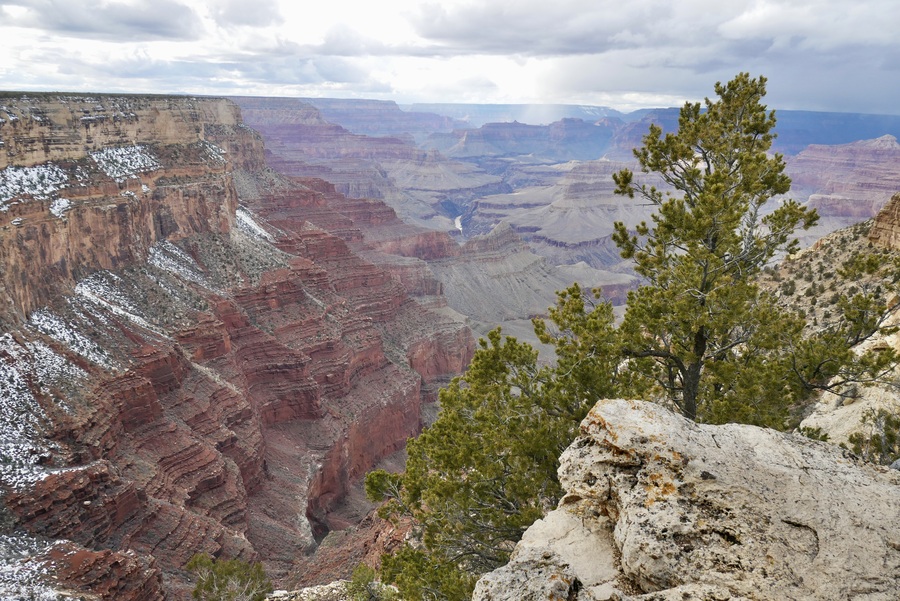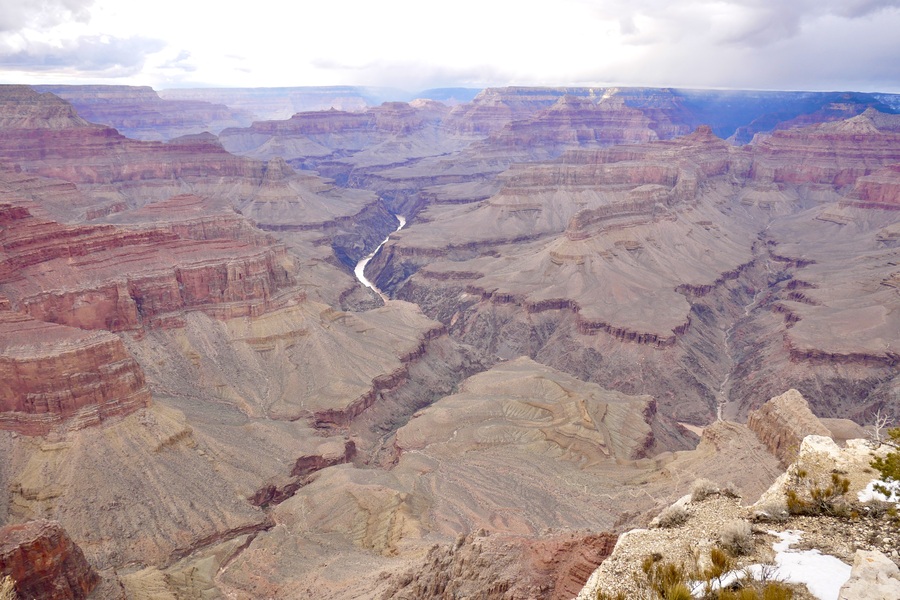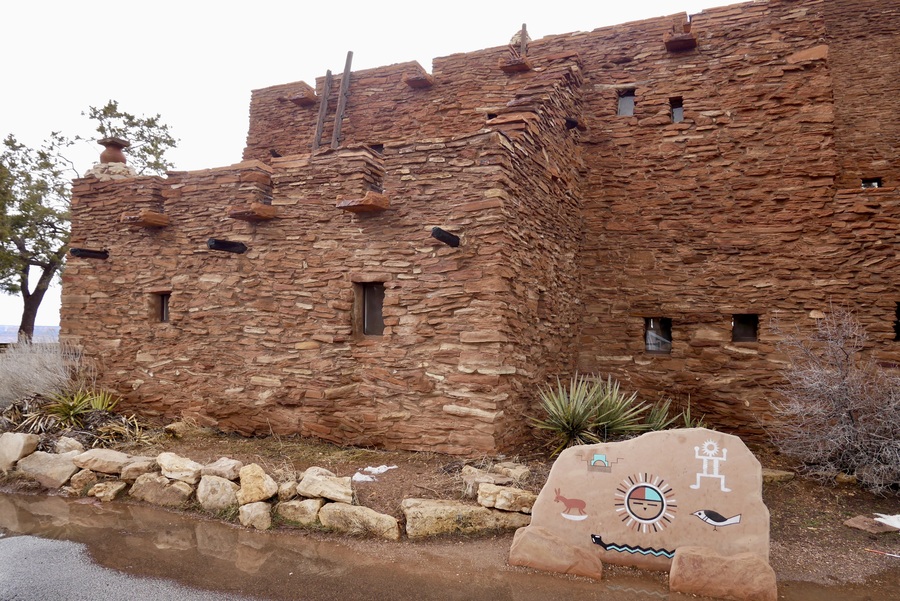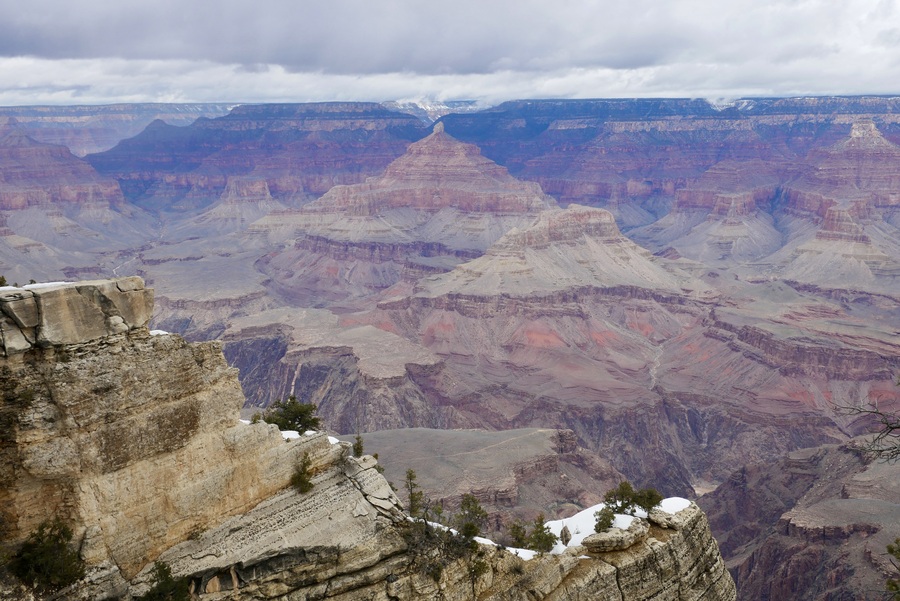
Grand Canyon South Rim: A Complete Guide
Few places on the planet inspire more awe than Arizona’s Grand Canyon National Park.
The cavernous river gorge—277 miles long, 18 miles wide, and 5,000 ft deep—slices through the vast Colorado Plateau in dramatic fashion.
The Grand Canyon is the gold standard of canyons around the world. Close to 5 million annual visitors descend on the sparsely-populated corner of Northern Arizona to peer down into its abyss. It is one of nature’s crowning achievements, one of the seven wonders of the natural world, and an unmissable North American travel destination.
South Rim of the Grand Canyon
The South Rim of the Grand Canyon is the national park’s most accessible section. It contains a bulk of the park’s tourism amenities and showcases its most awe-inspiring viewpoints. The South Rim is located more than three hours away from the North Rim by car.
The Grand Canyon’s South Rim contains dozens of overlooks to choose from, all located along the 32 miles of road from Hermit’s Rest to the Desert Watchtower.
These viewpoints lie along three main touring routes: the Red Line to Hermit’s Rest, the Orange line that connects Yavapai Point with Yaki Point, and the self-drive road to the Desert Watchtower.
The park’s Blue Line connects various destinations within the Grand Canyon Village, but it does not contain any of the South Rim’s most noteworthy panoramas.

South Rim Viewpoints: The Red Line
The Grand Canyon’s red line links nine spectacular scenic vistas. The route showcases panorama’s of the park’s western reaches and ends at the historic Hermit’s Rest.

Shuttle service along the Red Line runs from early March through late November. From December 1 to February 28, the road is open to private vehicle traffic.
You can access the Red Line from the Village Route Transfer stop on the Blue Line.
-
Trail Overlook
Trail Overlook, the first stop along the Red Line, provides the best aerial views of the Bright Angel Trail’s sinuous switchbacks.
At the overlook, you can see everything—from where the trial starts just west of the historic village, to where it finally disappears into the depths of the inner gorge 3,000 ft below.
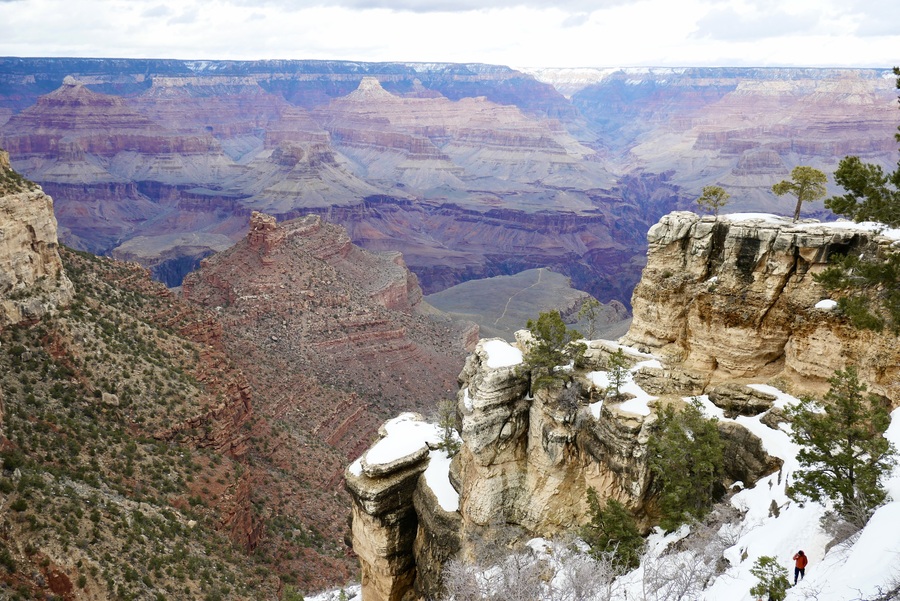
During our visit, we saw a few people attempting the Bright Angel Trail, but ice and snow obstructed much of the pathway.
-
Maricopa Point
At Maricopa Point, a narrow promontory juts out into the canyon, affording 180 degree views of the sprawling abyss. If you look closely, you might be able to see a tiny slice of the Colorado River, though you’ll get better views of the waterway at other spots along Hermit’s Road.
West of Maricopa Point you’ll find ruins of the former Orphan Lode Mine, which operated from 1891 to 1967.
-
Powell Point
Powell Point lies right next to Hopi Point, along the Hermit’s Rest bus route. As with the other stops along the route, it offers spectacular views of the Grand Canyon.
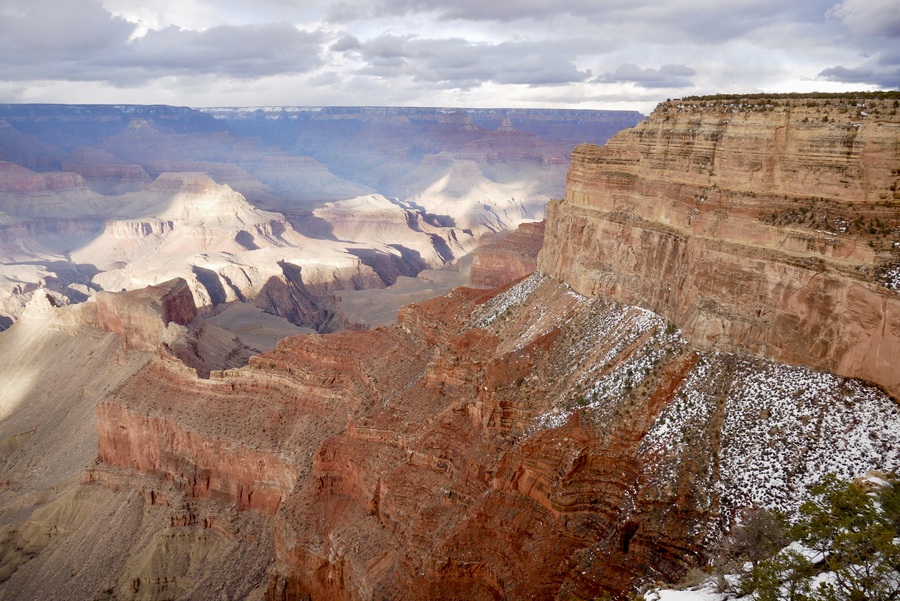
A large stone monument near the bus stop commemorates the 1869 Powell Expedition. Powell was the first known European explorer to map the river’s course by boat. He traveled along the Green and Colorado rivers, charting much of the American Southwest.
-
Hopi Point
Hopi Viewpoint is a breathtaking stop along Hermit Road. An ideal location for sunrise or sunset, Hopi Point also offers views of the Colorado River below.
Hopi Point lies a stone’s throw away from Powell Point. It is only served by shuttles in the westbound direction.
-
The Abyss
The Abyss offers a steep vertical view into the Monument Creek drainage area. Its sheer vertical drop is the longest and most precipitous along the South Rim of the Grand Canyon.
As you peer 3,000 ft into the depths of the canyon, you’ll be rewarded with views of Monument Creek, the Tonto Plateau, and the Colorado River.
-
Pima Point
Pima Point is the westernmost viewpoint along the Grand Canyon’s Rim Drive (though the road ends at Hermit’s Rest, 1.5 miles beyond).
From Pima Point, uninterrupted vistas showcase 40 miles of chiseled rock—From the Great Scenic Divide to Bright Angel Canyon.
Pima point is one of the only places from which you can hear the thunderous roar of the Colorado River, conditions permitting.
Unfortunately, on the rainy and windy day that we visited, we didn’t get so lucky.
-
Hermit’s Rest
Hermits Rest is the final stop along the Red Line. A historic rest stop, it is a popular place to recharge during a day of exploration.
While the views at Hermit’s Rest aren’t particularly noteworthy, the area serves as the gateway to magnificent backcountry hiking trails.
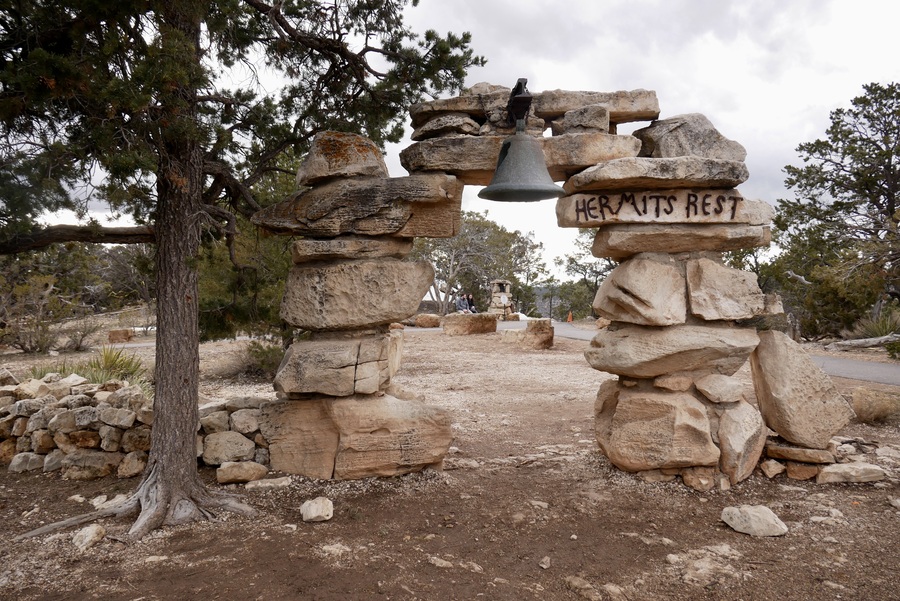
The historic stone structure at Hermit’s Rest, designed by architect Mary Colter, dates back to 1914. With its stonework, giant alcove fireplace, and front porch, it was built to resemble an old miner’s cabin.
Today, Hermit’s Rest offers a gift shop, a snack bar, and somewhat obstructed west end views of the Grand Canyon.
South Rim Stops: The Blue Line
The Grand Canyon National Park’s Blue Line connects the visitor center with the South Rim’s lodges, restaurants, and shopping areas.
Its end points are also the transfer stations for the Red Line and Orange Line (Hermit’s Rest Route Transfer for the former, Grand Canyon Visitor Center for the latter).

Though you likely won’t utilize the Blue Line for the South Rim’s best panoramas, the line is a logistical necessity for getting around the Grand Canyon—especially in the summer months when the park restricts private vehicles.
-
Grand Canyon Village
Grand Canyon Village is the hub of lodging inside the national park.
It is the largest example of town planning in the US national park system. At the village, you’ll find restaurants, shops, hotels, and connecting buses that will whisk you away to various viewpoints.
-
Hopi House
The historic Hopi House, located right on the rim of Grand Canyon, is among the most noteworthy structures in the park. The building, designed by Mary Colter, dates back to 1905. Its large, multi-story stone structure was modeled after the 1,000 year old pueblo in Old Oraibi, Arizona.
Originally designed as the main sales rooms for Fred Harvey Indian Arts, the building continues to house a gift shop filled with native handicrafts.
South Rim Viewpoints: The Orange Line
The Orange Route, also known as the Kaibab Rim Route, travels in a figure-8 loop between the Yavapai Geology Museum and Yaki Point. The route is about 50 minutes long and encompasses some of the canyon’s most jaw-dropping vistas.
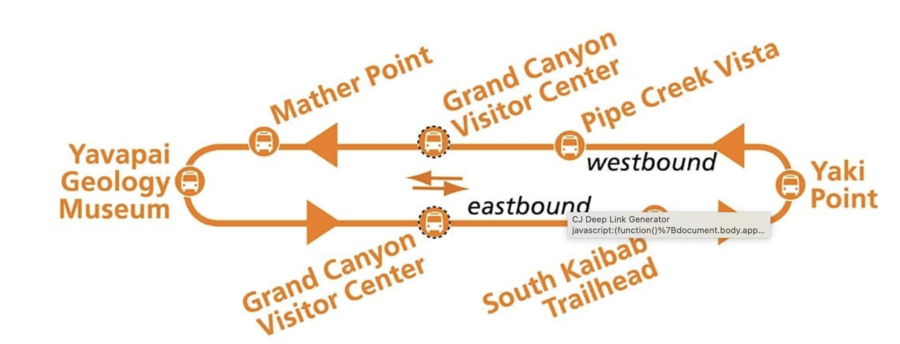
While the bus drops tourists off at the Grand Canyon Visitor Center in both directions, the majority of its eastbound and westbound stops differ.
I recommend you map out your Orange Line itinerary before your visit, in order to maximize your time in the area.
Highlights of the Kaibab Rim include Mather Point, the Yavapai Museum, and Yaki Point.
-
Mather Point
For many, Mather Point offers the first glimpse of the Grand Canyon. And what a glimpse it is.
Mather Point lies about five minutes away on foot from the park’s visitor center. It was the first viewpoint that we visited, and the one that remains most impressed in my memory.
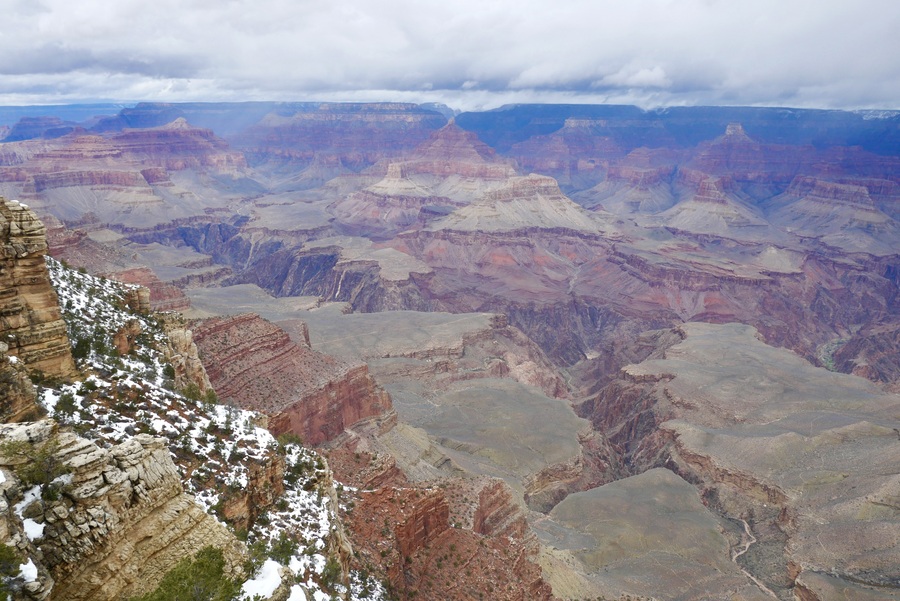
Thanks to its unobstructed views and ideal location, it is a favorite place to watch sunrises and sunsets.
-
Yavapai Point
Yavapai Point is the northernmost stop along the South Rim of the Grand Canyon. It boasts breathtaking sightlines of the area’s chiseled red rock.
The viewpoint is home the Yavapai Museum of Geology. The museum offers interactive exhibits, a small gift shop, and a canyon-viewing area.
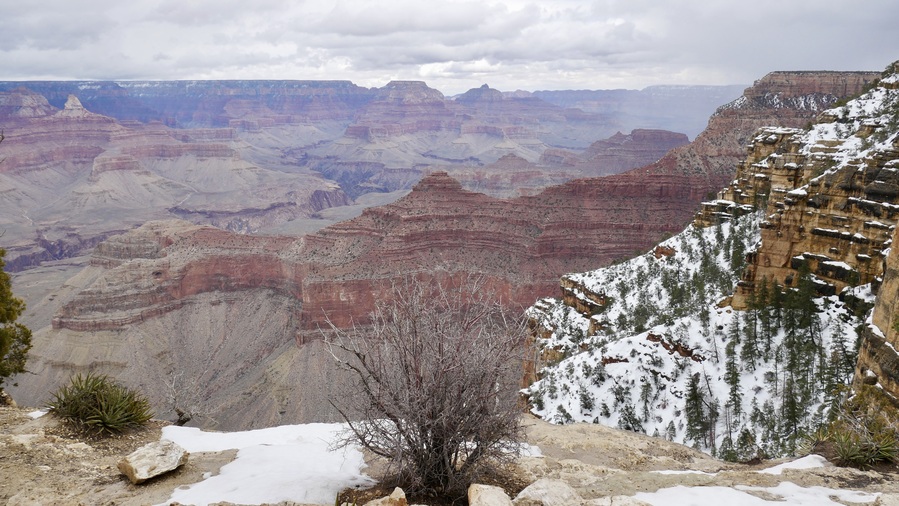
If you don’t feel like waiting for the shuttle, you can reach Yavapai Point via the Rim Trail from Mather Point.
-
Yaki Point
Yaki Point lies at the end of the Orange Line.
From its viewing area, you can look down at the South Kaibab Trail as it weaves its way to the Colorado River. It also boasts some of the park’s best eastward views.
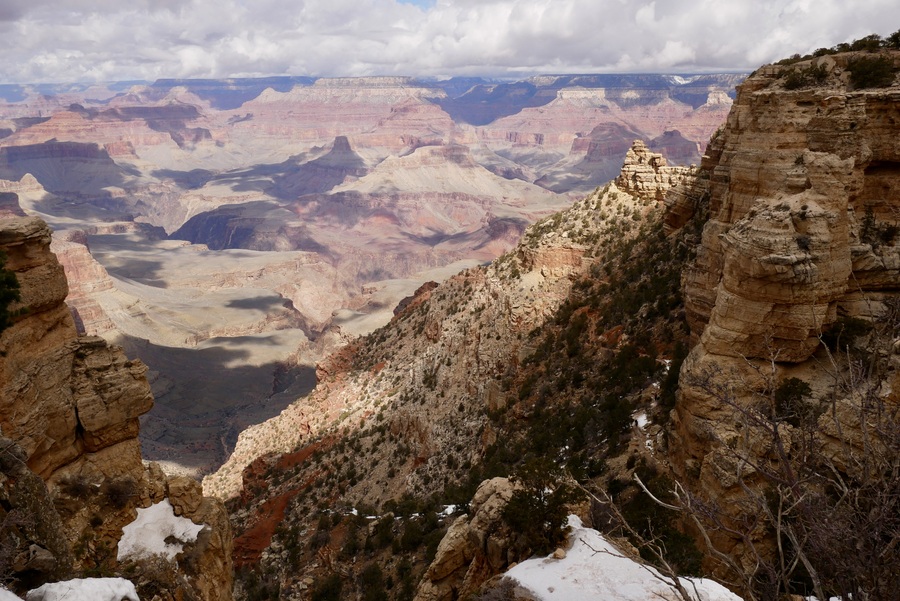
Yaki Point is the only stop along Desert View Drive that is closed to private vehicles. The scenic overlook can be reached using the park’s Orange Route.
Desert View Drive
Desert View Drive is open to vehicle traffic year-round and cannot be accessed using the national park’s tourist shuttle.
A lot of people skip this part of the park, which is a shame. Its lookouts are every bit as magical as those along the red and orange lines.
-
East Drive Viewpoints
Desert View Drive highlights awe-inspiring panoramas of the Grand Canyon’s eastern reaches. While it is slightly less trafficked than other areas of the park, it is every bit as dramatic.
Popular points of interest along Desert View Drive include Grandview Point, Moran Point, Lipan Point, and Desert View.
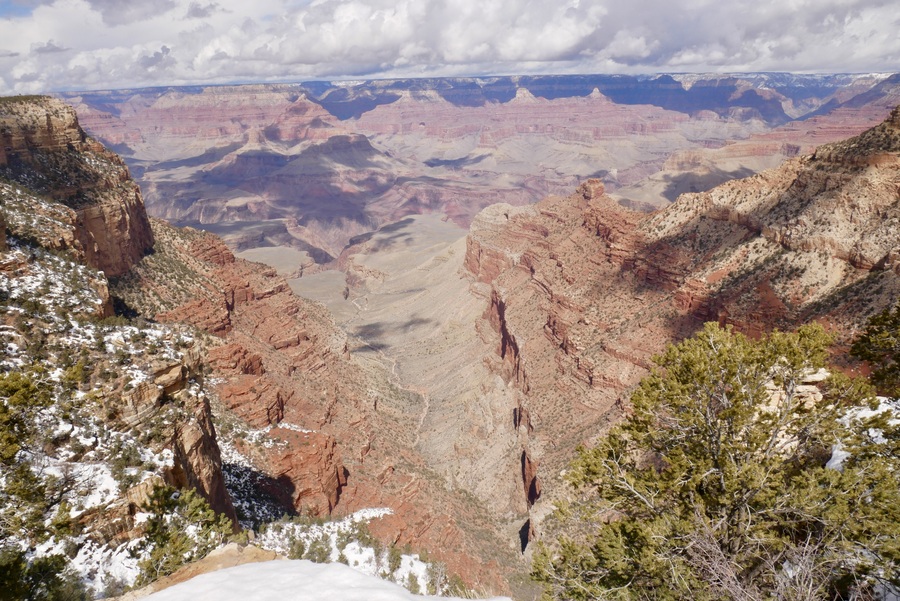
Though we managed to make a quit pitstop at all the overlooks, this self-drive part of our itinerary was a bit rushed due to Elio’s nap schedule.
-
Desert View Watchtower
Desert View is the easternmost point along the developed portion of the Grand Canyon’s South Rim.
Aside from its spectacular vistas, the site is noteworthy for its 1932 lookout tower designed by Mary Colter. The tower, modeled after an Ancestral Puebloan structure, stands guard over the canyon.
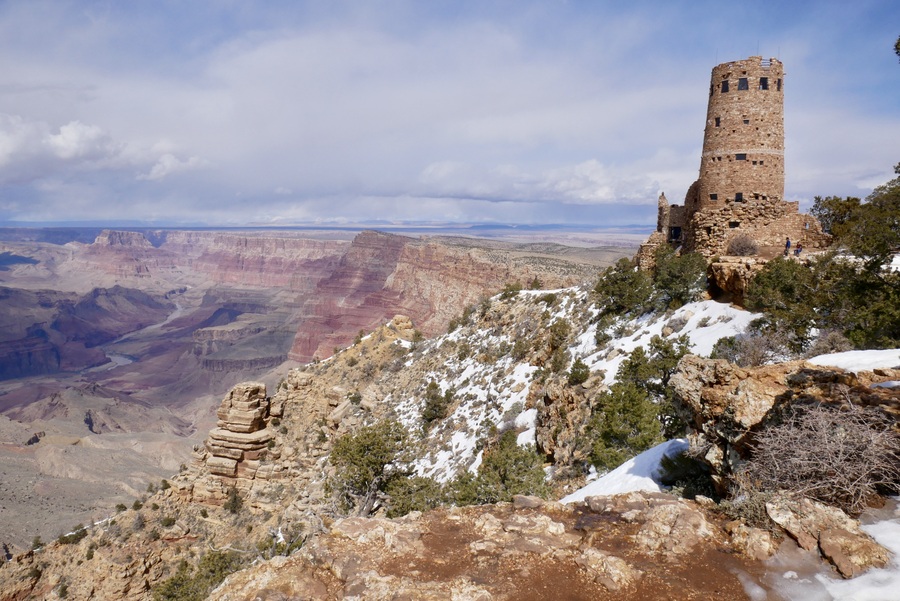
Access to the top of the tower is free of charge. It is open daily from 9am-5pm.
Getting Around the Grand Canyon South Rim
During winter months, you can bring your own vehicle to the park’s main viewpoints and places of interest.
However, during peak tourist season, you’ll have to rely on the national park’s efficient tourist shuttle.
Free Shuttle buses operate in and around the South Rim of the Grand Canyon. They link most of the major tourist areas, excluding Desert View Drive.
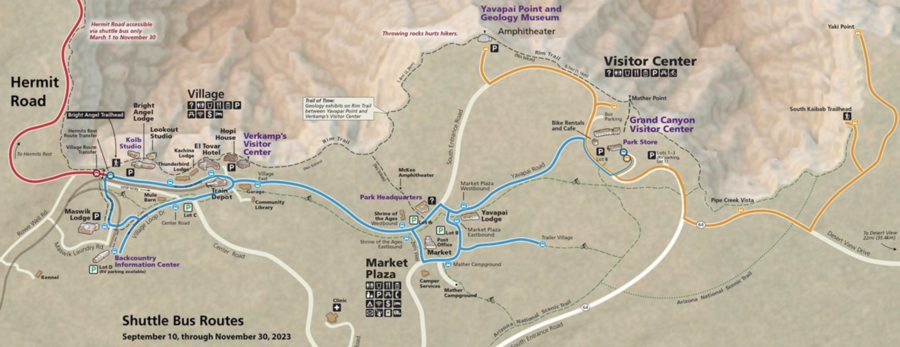
The South Rim buses provide transportation between the visitor center, lodges, campgrounds and viewpoints.
Alternatively, you can get around the Grand Canyon by bike or on foot. The 13 mile Rim Trail connects most places of interest along the South Rim.
Grand Canyon Tours
While I’m personally a big fan of DIY travel, I realize that not everyone wants to deal with logistics and planning. Luckily, there are hundreds of Grand Canyon tours that can help you make the most of your visit.
Even if you’re planning on taking the park shuttle around, tours can provide a way of seeing the Grand Canyon from a different vantage point.
Scenic helicopter tours are a popular option for travelers who wish to take in the canyon’s awesomeness from the sky. There are also options for backroad safaris, rafting tours, and hiking tours.
Where to Stay near the Grand Canyon South Rim
You’ll find a combination of national park lodges, campgrounds, hotels and cabins both inside and outside the Grand Canyon National Park’s borders.
-
Inside Grand Canyon National Park
If you’ve booked early enough to secure a spot and your budget allows for a bit of a splurge, there are a number of different lodging options along the South Rim. These include the Bright Angel Lodge and Cabins, Thunderbird Lodge, and Maswik Lodge.
The historic El Tovar Hotel is the most renowned place to stay within the national park’s boundaries. It is widely considered to be the crown jewel of national park lodges.
-
Near the South Rim Entrance
Tusayan is the closest town to the national park entrance. It offers a combination of independent and international chain hotels. Due to Tusayan’s proximity to the park, the prices can be quite high for what you’re getting. We found better prices farther south, in the town of Valle.
During our visit, we stayed at the Grand Canyon Inn and Motel in Valle. And while it wasn’t anything particularly fancy, we found that the room suited our needs (and price point).
If you’re looking to stay in Tusayan for proximity’s sake, you may want to consider the Grand Hotel or the Holiday Inn Express Grand Canyon.
Grand Canyon Entrance Fees
Entering Grand Canyon National Park costs $35 per vehicle or $20 per person (for those who travel on foot or by bike). Annual interagency passes are also accepted and can be obtained online or at the park’s entrance kiosks. The interagency passes a great value for travelers who plan on visiting multiple U.S. national parks within a calendar year.
Since we frequently visit federal lands, Dan and I always make sure we have an up-to-date interagency pass. The pass has always paid for itself.
When to Visit the Grand Canyon
The Grand Canyon is a year-round tourist attraction. Peak season encompasses summer months and school holidays. During these times, expect large crowds, traffic jams to enter the park, and hotels booked to capacity.
Spring and fall are great times to visit the park due to pleasant weather and thinner crowds.
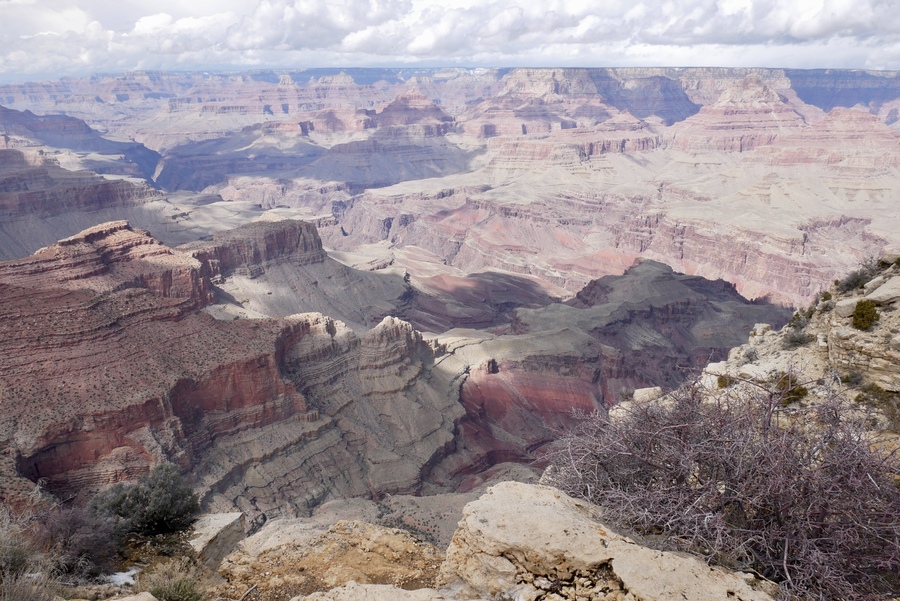
Winter is the Grand Canyon’s off-season. Between November and March, low temperatures bring fewer visitors. When we visited in March, ice still covered many of the park’s trails—impeding our descent below the canyon’s rim.
If you’re looking to hike below the Grand Canyon’s rim, you should probably avoid the winter months.
Grand Canyon Sunrises and Sunsets
Mather Point is one of the most popular sunrise-viewing destinations within Grand Canyon National Park. The viewpoint’s proximity to the park entrance and visitor center is an added bonus.
Others have recommended Ooh Aah Point, Yavapai Point, and Yaki Point for sunrise.
However, since we were traveling with a toddler and staying outside of the park’s entrance gates, we don’t have first hand recommendations for sunrise-viewing.
Sunset over the Grand Canyon is magical, too.
As the sun sinks lower in the sky, it ignites the canyon walls in fiery shades of red and orange. Top sunset viewpoints on the South Rim are Mojave Point, Hopi Point, and Pima Point.
Other Ways to Experience the Grand Canyon
Going from viewpoint to viewpoint is the easiest way to visit the Grand Canyon, but it is by no means the only option. Adventure-lovers and thrill-seekers can experience the canyon in a plethora of different ways.
-
Hiking
The Bright Angel Trail is one of the most popular hiking trails in the Grand Canyon. It starts on the canyon’s rim and ends 9.5 miles later at the Colorado River. Most people hike just a few miles below the rim before turning back. Popular stopping points are the 1.5 Mile resthouse, the 3 Mile resthouse, and the Indian Garden.
-
Rafting
The Colorado River is one of the world’s top bucket list rafting destinations. Over the course of a week, rafting trips will take you through the canyon, along the Colorado River. Those who choose to raft the Grand Canyon say that it is a trip of a lifetime.
-
Biking
Bicycles and e-bikes are allowed on all paved and unpaved roads on the South Rim. You can rent wheels at Bright Angel Bicycles, adjacent to the Grand Canyon Visitor Center.
Beyond the Grand Canyon
The Grand Canyon lies in northern Arizona, amidst a red rock wonderland that includes some of the most stunning geological marvels in the world. Just two hours south of the Grand Canyon, you’ll find the red rock paradise of Sedona Arizona.
Two hours to the northeast, sits the small Page—gateway to Upper and Lower Antelope Canyons.
Beyond Page, you can easily incorporate the Grand Canyon into a larger road trip around the American Southwest. Petrified Forest National Park and Monument Valley are just a few hours away to the east. And the five incredible national parks in Utah (Bryce, Zion, Capitol Reef, Arches, and Canyonlands) lie a few hours to the north.
****
The Grand Canyon isn’t the deepest canyon in the United States (that title belongs to Hells Canyon on the Oregon/Idaho border), but it is certainly the most famous.
Arizona’s cavernous river gorge is one of the seven wonders of the natural world. Other famous canyons (the Fish River Canyon in Namibia, the Blyde River Canyon in South Africa, the Colca Canyon in Peru, for example) all use Arizona’s massive river gorge as their standard of comparison.
It’s truly a place that needs no introduction; one that is perhaps more renowned than any other geographic landmark in North America.
Whether you’re hiking to its depths, photographing its sunset hues, or peering over its cavernous abyss, the Grand Canyon in Arizona is sure to fill you with wonder.


